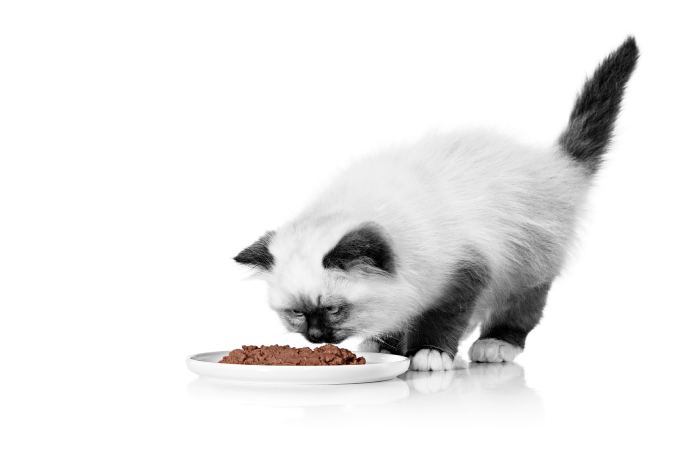Start of Life Report
Article

A NEW PUPPY OR KITTEN ADDS JOY TO ANY HOUSEHOLD
Canadian Pet Owners are Hungry for the Facts
9 in 10 pet owners
9 in 10 pet owners
AND...They know nutrition matters.
Dog owners
Cat owners
7 in 10
2 in 5
Only about half
Felt well informed when purchasing their dog or cat food for the first time
Why Choose Specific Food for Puppies and Kittens?
Food, over the few first months of life, does more than give puppies and kittens the energy to get through playtime. These new family members on four legs are going through big changes, growing and developing each day. The right nutritional choice from the beginning plays a vital role in influencing how strong and healthy they become, along with how their brain develops.
Plus, with early development of the immune system, teeth, and digestion, kittens and puppies have very specific needs, and different breeds can benefit from specific nutritional formulas.
Did you know?
Have an appropriate energy provision and quality protein to aid growth
Support developing immune systems
Support developing immune systems
Be tailored to jaw and teeth structure and size
Have the right nutrients to aid cognitive, skeletal and cell growth and development
Start of Life: Go-To Guidelines
BALANCE
A pet food’s nutritional balance should meet your puppy or kittens’ precise needs for their age, breed, lifestyle and sensitivities. Specifically, striking the right balance of energy, protein, fat, carbohydrates, vitamins, and minerals is critical.
That’s one reason homemade puppy or kitten food may not be as reliable as commercial pet foods that are scientifically backed and specifically formulated for puppies and kittens.
With specialized ingredients, individual recipes are formulated to deliver the appropriate level of nutrients, including antioxidants, fibre and prebiotics, that meet your pet’s unique needs.
This will be beneficial first at puppyhood and kittenhood; and then as they grow reaching new milestones, they may require a diet specific to their health needs.
NUTRIENT BENEFITS AT A GLANCE
Every nutrient has a role to play in keeping puppies and kittens healthy.
While they each do several different important jobs, they can also work together to meet the needs of a specific breed or age of animal. For example, each of Royal Canin’s tailored diets may include 50 or more individual nutrients, adapted to a pet’s unique needs.
Protein
Builds and maintains muscle mass and supports immunity
Carbohydrates (fibre)
Help pets feel full to avoid overeating
Lipids (fats)
Improve palatability and help animals absorb certain vitamins
Minerals
Support proper bone development and skin health
Vitamins
Support formation of blood cells and protection from cell damage

Palatability
Most humans would agree that the taste of our food matters a great deal. It’s no less important for our pets, especially little ones.
Puppies and kittens are sensitive to smells and textures – but their taste is less developed. So, food formulated to be highly palatable is key to ensuring proper nutrition. Owners should look for puppy and kitten food that has been palatability tested.
Digestibility
Puppies and kittens have sensitive digestive systems. An upset tummy isn’t just momentarily unpleasant, either.
Without proper digestion, puppies and kittens may not absorb the nutrients they need to grow and remain healthy. Finding a food that’s formulated to be highly digestible will help make sure your furry loved one gets the most out of every bite.
Safety
Make sure to provide puppies or kittens with foods tested to meet high quality and food safety standards. Be sure to know which human foods may be toxic or dangerous to puppies and kittens as well.
Cooked bones, fatty foods, chocolate, coffee, several types of nuts, onions, garlic, cherries, and grapes are just a handful of examples of food that while tasty for us, are dangerous for pets. Be mindful of dropping food while preparing meals and avoid giving your puppy or kitten table scraps.
Size
Controlling portions – including for your pet’s specific breed and eventual adult weight – is important from the start. Owners should also look for food that was designed for their pet’s breed specifically, from extra small to giant, to ensure the food and shape is suited to their puppy or kitten. Check the feeding guidelines on the food packaging and measure each portion carefully.
For puppies, it’s best to split their daily recommended food portion into small meals throughout the day. Kittens, meanwhile, prefer to graze and eat multiple small meals a day. Offering a set amount of food per day and allowing the kitten to eat when they want taps into their natural grazing tendencies. However, some pet owners may stick to set feeding times, or combine leaving out measured portions of dry kibble with set times for wet food portions.
As your puppy or kitten reaches new milestones, you may need to adjust the portion size. Remember, “adulthood” is different for each puppy breed – it could be anywhere from 8 to 24 months. Similarly, kittens reach adulthood around 12 to 15 months, depending on the size and type of cat. Consult with your veterinarian for more information specific to your pet.
MIX IT UP
Consider introducing mixed feeding – or offering both dry kibble and wet food – to your pet at an early age.
Combining wet and dry food will not only help to avoid fussy eating behaviour later in life but can also help your pet stay hydrated.
CREATE THE RIGHT DINING ATMOSPHERE
Puppies and kittens are sensitive to their environments. Kittens prefer to eat somewhere calm, out of sight and with an easy escape route, and away from their litter box. People arriving or talking, lighting changes and sudden noises can all influence how much a kitten eats, so keeping their dining area in a calm spot can make all the difference.
Puppies, meanwhile, thrive on routine. To help them feel secure, and avoid upsetting their digestion, give them the same food, preferably at the same times, in the same place, using the same bowl every day.
Creating a feeding area away from where human family members eat can also help your pet avoid temptation or ingesting foods they shouldn’t have. You should also introduce puzzle feeders or interactive feeders to increase mealtime and keep both kittens and puppies stimulated! Talk with your veterinary team about the best type of interactive feeder for your pet!
WATER, EVERYWHERE
Keeping puppies and kittens hydrated is essential for their health.
Access to clean, fresh water in multiple places throughout their home is best. Change their water daily and use porcelain, ceramic or stainless steel bowls instead of plastic.
Like & share this page